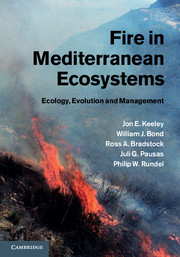1 - Mediterranean-type Climate Ecosystems and Fire
from Section I - Introduction
Published online by Cambridge University Press: 05 January 2012
Summary
This book is about fire and the ecosystem role it plays in plant communities with distributions centered in one of the five mediterranean-type climate (MTC) regions of the world (Fig. 1.1). These landscapes are related by their marked climatic seasonality, with precipitation in the winter under mild temperatures and drought in the summer coupled with high temperatures (Box 1.1). MTCs are regions where precipitation exceeds potential evapotranspiration during the rainy season (Rundel 2010), resulting in sufficient plant growth that becomes highly flammable during the summer dry season, a unifying factor that has played out in common ecological responses to fire. Collectively these regions comprise only about 2% of the land area of the world but they house more than 15% of the total vascular plant flora (Rundel 2004). All are dominated by fire-prone ecosystems often juxtaposed with major metropolitan centers (Fig. 1.2) and are dominated by fire-adapted vegetation resulting from a long evolutionary association with fire (Pausas & Keeley 2009).
- Type
- Chapter
- Information
- Fire in Mediterranean EcosystemsEcology, Evolution and Management, pp. 3 - 29Publisher: Cambridge University PressPrint publication year: 2011



